Your Thanksgiving turkey keeps escaping! In this turkey STEM challenge, your kids will need to come up with a turkey cage design to keep the turkey nice and safe.
My kids love the How to Catch series. So we were super excited when we saw that there was a How to Catch a Turkey that is perfect for Thanksgiving!
The premise of the book is that a turkey is running loose in a school right before a Thanksgiving play, and the kids have to help catch it. Don’t worry, no turkey is harmed in the making of this book!
In the spirit of making sure we don’t have any runaway turkeys to trap this Thanksgiving, we took up the Thanksgiving Turkey STEM challenge! We are going to nip the problem of runaway turkeys in the bud and devise a cage to contain our turkeys.
If you want to follow the plot of the How to Catch a Turkey book, you can turn this challenge into a turkey trap project. The same design rules apply, but instead of a cage, you are now building a trap to catch the turkey!
The Thanksgiving season provides a fun opportunity to engage students in STEM (science, technology, engineering, and math) learning with a holiday twist Designing turkey traps allows kids to flex their creative thinking and problem-solving skills through an entertaining activity Follow this step-by-step guide to successfully implement a how to catch a turkey STEM challenge in your classroom or home.
What is a Turkey Trap STEM Activity?
A turkey trap STEM activity presents students with the real-world scenario that they need to catch a turkey for Thanksgiving dinner. Their challenge is to design and build a working turkey trap using everyday materials like cardboard, tape string pipe cleaners etc.
Students must employ engineering and design skills to ideate construct, and test their trap. This hands-on project seamlessly integrates multiple academic skills from math and science to literacy.
Why is it an Effective STEM Activity?
Turkey trap building allows students to engage in the engineering design process in an authentic way. This inquiry-based learning experience enables them to:
- Apply math and science concepts to solve a real-world problem
- Utilize creativity and critical thinking to design solutions
- Develop planning, collaboration and communication abilities
- Gain perseverance through testing and troubleshooting designs
- Make connections between STEM and their daily lives
Because kids are intrinsically motivated to catch the turkey, they are eager to trial and refine their ideas. The activity provides an opportunity to cultivate persistence and resilience.
Setting Up a Turkey Trap STEM Challenge
Follow these tips to prepare your how to catch a turkey STEM activity:
Choose Materials
Provide craft supplies like cardboard, tape, string, straws, paper clips etc. Avoid giving too many options to simplify the design process.
Explain the Scenario
Describe how students need to build a trap to catch a turkey for Thanksgiving dinner since the stores are sold out.
Brainstorm and Plan
Let kids sketch trap designs and encourage collaboration. Allow time for planning before building.
Set Parameters
Provide size limits, material quantities or other constraints to add challenge.
Build and Test
Allow sufficient time for construction and multiple tests of trap designs.
Reflect and Improve
Have students evaluate traps and pinpoint potential modifications to improve performance.
Share and Discuss
Let groups demonstrate their traps and discuss which designs worked best and why.
Turkey Trap Design Ideas
Here are some common turkey trap designs to spark kids’ creativity:
Cage Trap
Build a cage with an opening that lures the turkey inside. Once entered, the door shuts behind them.
Net Trap
Engineer a pulley system to drop a net on the turkey. Students must figure out net size and rope setup.
Box Propped with Stick
Simple trap where a stick props up a box. Turkey enters for bait and knocks stick loose.
Pitfall Trap
Dig a hole and disguise it. Turkey falls in and walls are too high for them to escape.
Snare Trap
Make a loop that tightens on the turkey’s feet when entered. Position over food bait.
Setting Up Stations
If space permits, set up distinct stations for planning, designing, building, and testing. This allows multiple groups to work at once. Display visual reminders of the engineering design process at stations.
Provide clipboards, graph paper, pencils and designing templates to promote planning. For building, ensure safety by overseeing use of sharp tools like scissors or craft knives. Keep testing materials like turkey figures near the building station.
Differentiating Instruction
Modify the activity to suit all ability levels:
-
For advanced students, impose more limiting design constraints.
-
Struggling students benefit from additional planning time or simpler material options.
-
Pair students up and assign roles like materials manager, sketcher, builder etc.
-
Allow groups to obtain feedback throughout process rather than just at the end.
-
Encourage peer collaboration by having groups examine and advise each other.
Ideas for Extending the Activity
-
Compare trap designs to real-world examples like NH fish and game traps
-
Research and discuss ethical factors around trapping wild animals
-
Write a story from the turkey’s perspective about being caught
-
Examine the simple machines evident in the traps like levers, pulleys, inclined planes etc.
-
Estimate measurements and costs to build traps on a larger scale
Linking to Curriculum Standards
Designing turkey traps is an engaging way to target these educational standards:
Math
- Measurement and data
- Geometry
- Mathematical modeling
Science
- Engineering design process
- Forces and motion
- Structure and function
Literacy
- Following instructions
- Presenting ideas
- Collaborative discussion
21st Century Skills
- Creativity
- Critical thinking
- Communication
- Collaboration
Evaluating Student Learning
Assess student growth and trap designs through:
-
Rubrics assessing planning, construction, testing and teamwork
-
Journal reflections on designs, improvements, and concepts learned
-
Peer evaluation forms to provide constructive feedback
-
Class discussions and trap demonstrations
-
Teacher observation of collaboration and engagement
Creating an Engaging Experience
The key to a successful turkey trap STEM activity is student engagement. Make it fun and memorable with:
-
An exciting backstory – explain the Thanksgiving dinner emergency
-
Turkey figures for testing – stuffed animals or paper print outs
-
Fun materials like cardboard, string, straws etc.
-
Collaboration between teams
-
Opportunities for peer feedback and trap showcasing
-
Incorporating book tie-ins like “How to Catch a Turkey”
Designing functional turkey traps engages students in the engineering design process while building STEM skills in an authentic context. With some simple setup, this activity can be tailored to any grade level and transformed into a hands-on learning experience kids will love. Empower your students this Thanksgiving with the creative challenge of catching a turkey!

Build a Turkey Cage STEM Challenge
- Materials to build the cage, such as mini marshmallows, toothpicks, toilet paper rolls, straws, popsicle sticks, pipe cleaners, masking tape, etc.
- Free turkey cage challenge template (click on the at the bottom of this post to grab the printable)
1. Determine how many turkeys you would like the cage to hold. We decided to go with 3.
2. Print out the free printable turkeys template, cut out the turkeys, and tape the bottom tabs together. Your turkey(s) should be able to stand on its own.
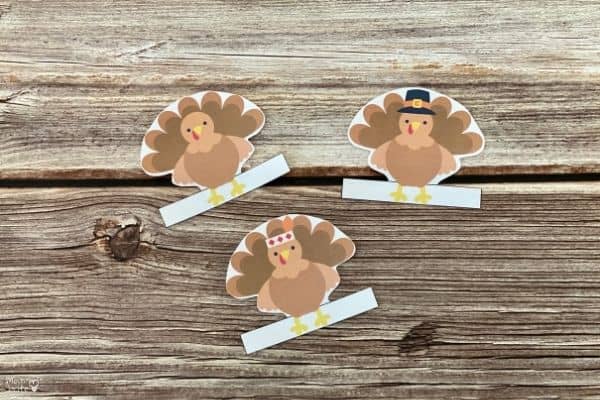
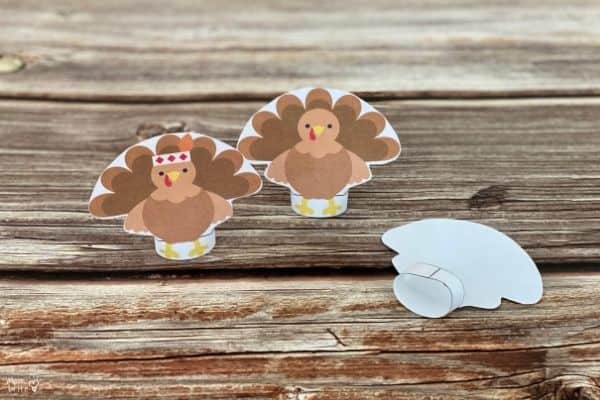
3. Give your kid materials to build the cage.
I suggest giving him a limited number of materials because too many choices could be overwhelming. You can always repeat the challenge with another set of materials. We used marshmallows and toothpicks for our challenge.
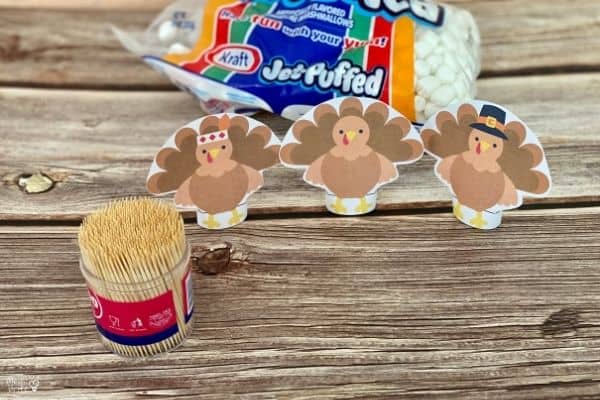
4. Have your child build the cage, jump in to help only if necessary. Let him use his imagination to come up with the cage design!
5. After the cage is finished, test to see if the cage can hold the turkey(s). Ask him what improvements would he implement to the cage, if any.
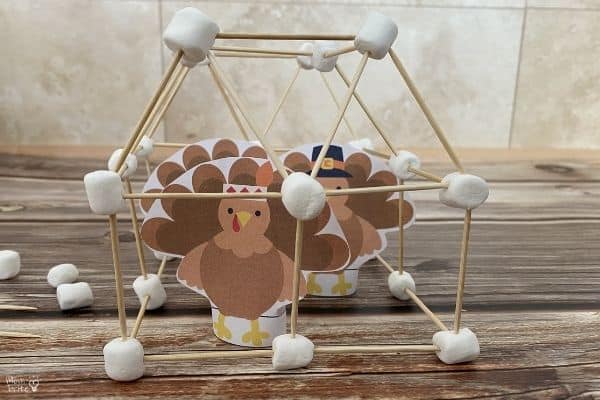
My kids absolutely love STEM challenges like this because there are very limited restrictions on what they could do. They could use their imagination and creativity to come up with all kinds of cages!
If you decide to use marshmallows and toothpicks like us, here is a potential cage design for holding 3 turkeys.
My kids first started building the cage by constructing a fence around the turkey. They realized that the fence was not very tall and that the turkeys could jump over it.
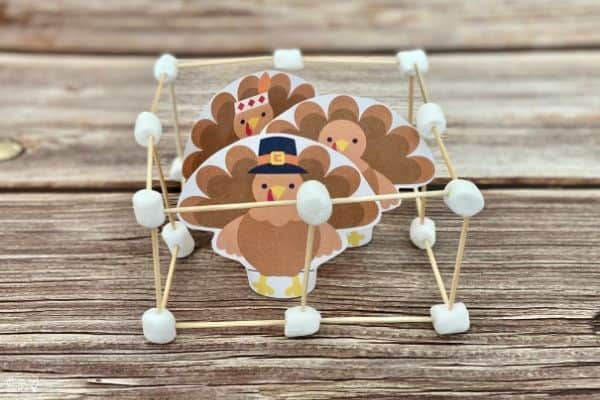
Then we constructed a roof to the cage so that the turkey couldn’t get out from the top.
When I asked my kids how we could improve this cage, they said that they would like to make it stronger and that it would be nice to have a door for the turkeys to get in and out.
We ended up placing a few more sticks to make the cage more sturdy, but we couldn’t come up with a way to make a cage door. Perhaps next time with different supplies!
Thanksgiving Turkey Cage STEM Challenge Printable
This turkey cage STEM activity sharpens your kids’ problem-solving and engineering skills. You can use it in a classroom with your students or even at a Thanksgiving party to keep the kids entertained while waiting for dinner!
This Thanksgiving STEM activity is designed for preschool, kindergarten, and elementary students. The complete set of printables for this Thanksgiving STEM activity includes:
- Teacher instructions for turkey cage
- Turkeys template
- Student instructions for turkey cage (4 versions)
- Student planning page
- Student self-evaluation sheet
I included 4 versions of the student instruction sheet. The different versions give you the choice of whether or not you want the students to cage the bird for Thanksgiving dinner, or save the bird from being eaten. You also get a choice of whether or not you are holding multiple turkeys in the cage.
You can have your kids work together as a team to come up with the turkey cage, which is great for their collaboration and social skills.
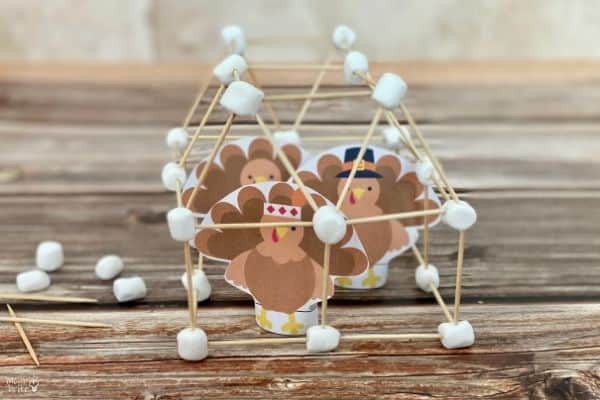
If you are using this Thanksgiving STEM activity in your classroom, make sure to set a time limit for the students to design and build the turkey traps. I recommend giving them about 5-10 minutes for brainstorming and design and then 20 minutes for construction.
How to Catch a Turkey STEM Activity
FAQ
How do you build a turkey stem activity?
How do you catch a turkey series?
How do you capture a turkey?
What is the Thanksgiving turkey STEM Challenge?
The premise of the book is that a turkey is running loose in a school right before a Thanksgiving play, and the kids have to help catch it. Don’t worry, no turkey is harmed in the making of this book! In the spirit of making sure we don’t have any runaway turkeys to trap this Thanksgiving, we took up the Thanksgiving Turkey STEM challenge!
How long does it take to build a turkey trap?
Give students approximately 30 minutes to build their turkey traps. Sit back and watch as students engage in real-world problem solving! At the end of the activity, be sure to have students describe and demonstrate how their trap works.
How do I engage my students in a real-world STEM Challenge?
Follow these step-by-step instructions to engage your students in this real-world STEM challenge! Divide students into groups of 3-4. Explain to students the following scenario: Your family forgot to get a turkey for Thanksgiving and the stores are all sold out!
How can I increase student engagement with stem?
One of our favorite ways to increase student engagement is with STEM, and one of our favorite STEM activities is building a turkey trap. Follow these step-by-step instructions to engage your students in this real-world STEM challenge!
